Non-Fiction Book Reviews
Discover reviews of thought-provoking non-fiction books that explore ESG themes—both directly and through broader lenses like climate, ethics, economics, and sustainability. Each review offers key takeaways and insights to help you expand your ESG perspective.
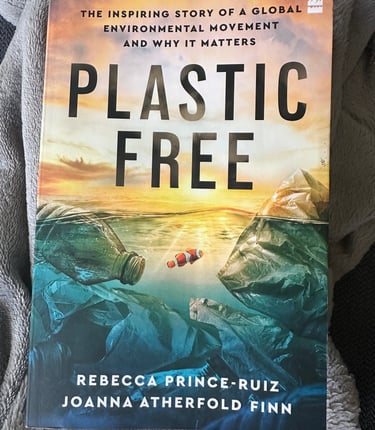

Plastic Free by Rebecca Prince-Ruiz and Joanna Atherfold Finn
The elephant in the room - plastic waste! I've used an idiom that unfairly compares a beautiful creature impacted by our involvement in the complex web of plastic pollution. A thought-provoking book that instills a new way of thinking about an individual's contribution to many of the world's most challenging problems. This book does not aim to place blame or dictate actions. It simply aims to promote the idea that we are part of a community that can help identify ways to reduce plastic waste, recognize our shared responsibility, and make the world better for all living beings on Earth.
Key takeaways:
• Being mindful of what your waste consists of and how you can reduce it would be a starting point for your conscious efforts. For tips and advice check out: https://www.plasticfreejuly.org
• Reducing plastic waste to zero can be very challenging. It starts with taking steps and assessing what works best for you and what doesn't. Eventually, you can work your way through trial and error, and find innovative solutions.
• Consumers play a role in encouraging manufacturers, producers, local authorities, and other parties to do better through their consumption patterns. Your actions matter and make a difference - however small or big make a difference in your life and the lives of other living beings.
• Take a step back to think about and research the cycle of where waste goes and its impact. How much plastic waste is really going to be recycled? It makes a difference to think about what is downcycled (to end of life) and what is recycled.
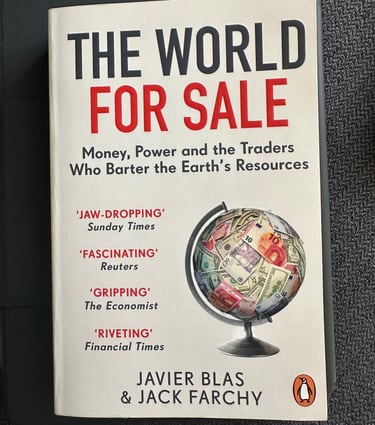

The World For Sale by Javier Blas and Jack Farchy
You may be wondering: 'Why is this book review on a platform related to ESG and sustainability?!'. This compelling read offers a crucial perspective that every sustainability thinker should consider. It pulls back the curtain on the often unseen world of commodity traders — the powerful players whose decisions ripple through global markets and profoundly affect developing nations. Money talks, greed barks, and commodity traders walk this talk. The book aims to educate us on how commodities are moved globally, how developing countries rely on traders, and how courageous and influential traders drove the global markets to where they are now.
Key Takeaways:
The invisible power of commodity traders in global markets: Despite their outsized influence, commodity traders remain largely unseen by the public eye. Their decisions and strategies have helped shape the current state of global markets, influencing everything from resource availability to geopolitical stability and instability.
The complexity of commodity markets requires nuanced understanding: The book reveals how challenging it is to replicate the expertise and risk-taking of commodity traders. This complexity underscores why commodity markets operate as they do and why simple solutions to sustainability and economic development issues may fall short without addressing these market realities.
Developing countries face complex challenges within and beyond their borders: Developing nations and their role in global markets are often posed with challenges, and while it may not seem to be the responsibility of anyone else but the governing body of the country, we can't discard the fact that Supranationals could have played a role in curbing the trickledown effects of significant influence that commodity traders ended up having with governing parties in developing countries.

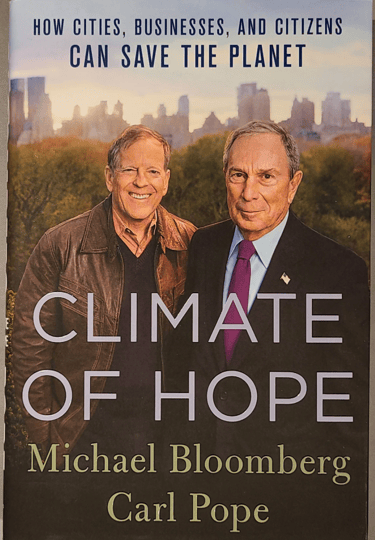
Climate of Hope brings together two distinct yet complementary perspectives—Michael Bloomberg, a business magnate (Bloomberg L.P) and former mayor of New York City, and Carl Pope, long-time environmental activist and former executive director of the Sierra Club. The book offers an insightful roadmap for tackling climate change from both the top-down and bottom-up by drawing on real-world examples. The authors highlight how cities across the globe are taking meaningful climate action—not only to mitigate global warming but to improve public health, enhance resilience to natural disasters, and protect biodiversity. From urban infrastructure and clean energy to transportation and agriculture, the book explores a wide range of sectors where change is already underway. While readers unfamiliar with the geography and politics of American cities may occasionally need to carry out their research, the book’s overall message remains powerful and accessible.
Key Takeaways:
Communication Matters: How we communicate climate change and it's consequences affects how it is perceived. Clear, and directional messaging is crucial to avoid skepticism.
Data Drives Action: Bloomberg’s adage, “If you can’t measure it, you can’t manage it,” highlights the need for transparency and reliable data to guide effective climate policies.
City-Led Solutions Inspire Change: Local governments and NGOs are proving that innovation, from renewables to water management and naturally enhancing carbon sinks, can deliver real impact and encourage other cities to learn and implement sustainable developments.
Relevant climate pieces form a Puzzle: The book outlines how seemingly separate issues—regulatory gaps, emissions outsourcing, building designs, financial incentives, agriculture, transport infrastructure, amongst other reasons—are interconnected. Tackling climate change requires a collaborative, systems-level approach.
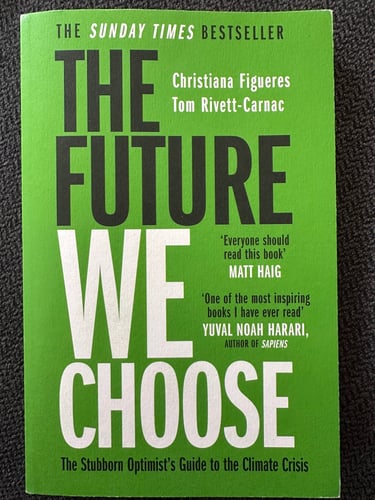

The Future We Choose by Christiana Figueres and Tom Rivett-Carnac
A compelling narrative from two individuals with different backgrounds but a shared vision: building a better future for today’s children and generations to come. The book presents two starkly contrasting paths for the modern world—one that is dystopian if we continue with “ignorance is bliss,” and another of collective determination toward a sustainable, regenerative future. It’s a must-read for everyone to begin to understand how we arrived at this climate crossroads—and how we can still course correct.
Key takeaways:
Collaboration and open source thinking: The authors advocate for a collective approach—learning together, co-creating, and raising awareness. This mindset fosters shared progress and ensures we are working toward common goals. Collaboration isn’t just beneficial—it’s essential.
Choosing not to ignore the world's problems: In today’s digital world, it's nearly impossible to avoid news of climate, environmental, and humanitarian crises. While it may feel overwhelming—and tempting to scroll past—it’s important to resist disengagement. Everyone has a role to play, no matter the scale. Whether it's reducing your carbon footprint, spending time nurturing nature, or contributing positively to your community, every action counts.
Managing transitions with care: Whether you're a corporation, government, or individual, transitioning from traditional practices to climate-friendly alternatives takes time, thoughtful planning, and responsible leadership. Rapid, poorly managed change can cause harm or disruption. Misinformation and missteps can set us back for generations. Effective transition management is key to long-term sustainability.

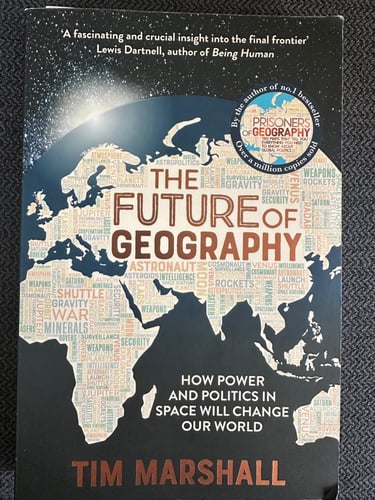
The Future of Geography by Tim Marshall
This masterpiece is a must read on space politics. It enhances the notion of knowing that as we admire the night sky, we should remember: there’s much more going on up there than meets the eye. Space politics directly influence ESG and are not abstract concerns. Much of the environmental and social data we rely on—such as monitoring forest cover, tracking Arctic ice loss, water stress, mapping disaster zones and more—comes from satellites. Their coverage enables global connectivity, facilitates trade, and supports climate modelling. Without space infrastructure, ESG analysis would be missing its most powerful observation tools.
Key Takeaways:
Manage and protect the near-Earth environment: Just as we safeguard ecosystems on Earth, we must also govern our actions above it. Orbital debris, satellite congestion, and geopolitical tensions over space access will directly affect our ability to collect data and respond to crises.
Extraterrestrial mining: A growing area of interest. Some organisations embracing 'the final frontier' are exploring ways to extract rare minerals from asteroids and the Moon. While this may promise new resources, it brings complex geopolitical, environmental, and ethical challenges—especially when linked to supply chains for critical raw materials.
Shaping our present and our future: For ESG practitioners, this means space governance, technology access, and geopolitical stability above Earth will be significant considerations—they are integral to sustainable decision-making.


'“Our lives are perched precariously on grains of salt and sand.” After reading Ed Conway’s Material World, these words stay with you long after you’ve turned the last page. This book takes a deep dive into the essential materials that underpin our modern existence—things we often take for granted without ever considering their origins or the complexity behind their creation. For anyone interested in sustainability or ESG, this is a must-read. Conway doesn’t just present facts; he takes you on a journey. From remote mining sites and awe-inspiring natural phenomena to roaring factories, he paints a vivid picture of how the building blocks of our world are extracted, transformed, and traded. The result is a powerful perspective on how interconnected our global systems truly are—and what it will take to achieve a greener future.
A few takeaways:
The Interwoven Lives of Materials - Materials weave together, or form a kind of cocktail, to become an essential final product. Most products are made from a complex mix of materials sourced globally. Even something as simple as glass relies on salt, sand, fossil fuels, and other resources to come into existence.
Materials on Their Global Journey - The origin story of materials is vast: from extraction in resource-rich environments, to transportation for processing, to manufacturing, and finally global distribution for consumption by people everywhere. Seen from nature’s perspective, this journey is exhausting and often unsustainable.
'Green transformations' and the Material Hurdle - As we aim to achieve net zero, the infrastructure for renewable energy—from wind turbines to solar panels—depends heavily on these very materials. Ensuring their sustainable sourcing is one of the greatest challenges to building a truly green future.


Review accessible on 30th November 2025
Disclosure
This website does not send email alerts, newsletters, or unsolicited subscription requests. All contact is initiated through the contact form, which enables direct communication via personal email for those who wish to engage further.
All users are encouraged to read our Terms and Conditions
